Hemp Protein Market Size
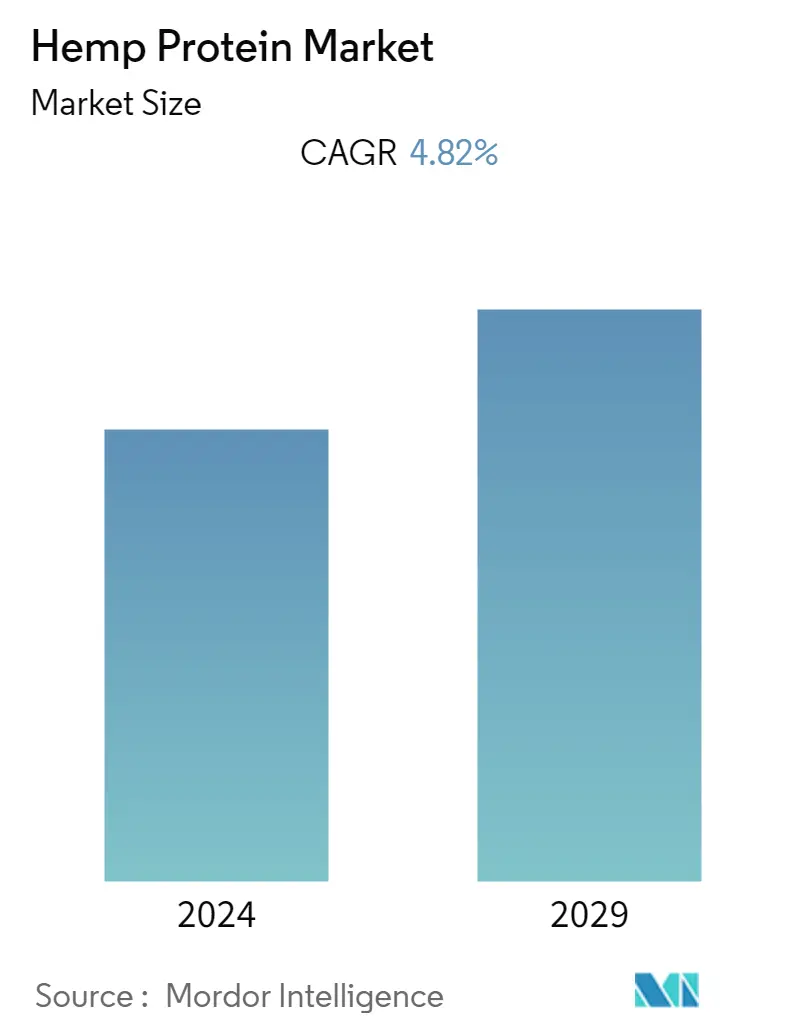
| Study Period | 2019 - 2029 |
| Base Year For Estimation | 2023 |
| CAGR | 4.82 % |
| Fastest Growing Market | Europe |
| Largest Market | North America |
| Market Concentration | Low |
Major Players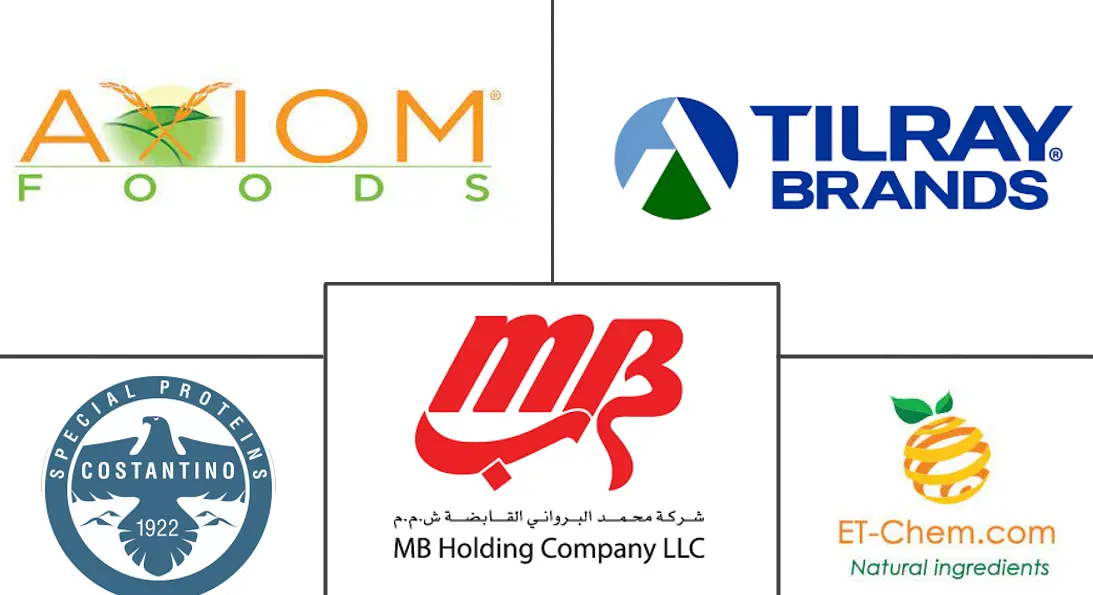
*Disclaimer: Major Players sorted in no particular order |
Hemp Protein Market Analysis
The hemp protein market size is expected to grow from USD 65.71 million in 2023 to USD 83.15 million by 2028, at a CAGR of 4.82% during the forecast period.
- Hemp proteins are easily digestible and are used as an active ingredient in various industry applications, including food and beverages, pharmaceuticals, personal care, and other industries. Additionally, the health benefits of hemp proteins, including anti-fatigue properties, enhancement of the immune system, and protective effects for the kidney, are attracting consumers to include hemp protein-based foods in their diets, which is eventually raising the industrial usage of hemp protein.
- Similarly, the growth of the hemp protein market is also being propelled by improved economic conditions, coupled with an increase in household wealth, due to which consumers have shown a willingness to spend on food products that are rich in hemp proteins to maintain their health.
- Moreover, plant-based bakery consumption is on a consistent rise and is estimated to be growing year-on-year. The trend is considered to be a typical offshoot of all-natural and clean-label eating shifts observed among consumers. This, on the other hand, is paving the way for potential ingredients that have been untapped by the market.
- In line with this, hemp protein often falls under the clean protein plant-based source that allows products to be made with organic and non-GMO ingredients and free from artificial sweeteners, colors, and preservatives. Hemp is naturally gluten-free, non-GMO, free of trypsin inhibitors, and virtually free of any form of residual chemicals. In addition, the hemp protein in the powdered form witnesses high demand as compared to the liquid form due to its increased shelf life, convenience, and other associated factors.
- Furthermore, the emerging trend of veganism has also helped in boosting the revenue of the market. Factors like minimally processed and chemical-free vegan food consumption patterns have also opened up opportunities for the market, allowing players to innovate and develop ingredients with multiple application capabilities.
- For instance, according to the Institute for Demoscopy Allensbach (IfD), in 2022, about 7.9 million people in Germany were either vegetarians or largely forgo meat consumption. Since 2014, the number of people identifying as either complete or nearly complete vegetarians has grown by approximately 2.51 million individuals.
- Hence, key players are focused on investing in researching hemp seeds to make them a good source of proteins, which is further expected to drive the market's growth. Furthermore, expanding the use of hemp seed protein in several industries may offer key opportunities for growth in the global market.
Hemp Protein Market Trends
Rising Preference for Plant-Based Protein
- With more focus on the particular forms of protein consumed, consumer interest in increasing protein intake is rising majorly owing to the increasing need for protein as a food-nutritional component. The high-protein diet trend is taking off and is expected to keep driving people's appetites in the future years.
- Similarly, the emergence of vegetable protein from sources like hemp demonstrates a change in customer demand from animal protein to plant protein with similar functional and nutritional characteristics. This incremental shift toward a plant-based diet is primarily influenced by various factors, including ecological concerns, health consciousness, ethical or religious beliefs, and environmental and animal rights. This combination of increasing need for protein consumption and rising demand for plant-based protein sources is expected to benefit the market's growth globally during the forecast period.
- Additionally, with growing health concerns due to meat consumption, consumers are inclined toward lowering meat consumption and incorporating plant-based protein sources into their diets, thus driving the market's growth, for instance, according to the GOV.UK, in 2020/2021, an average of 22 grams of meat and meat products were consumed per person per week, which has seen a significant low when compared to the previous year. In 2019/2020, an average of 92 grams of meat and meat products were consumed per person per week.
- Moreover, hemp protein is receiving more attention due to consumer demands for clear labeling, simple digestion, the need or desire to avoid allergens, compatibility with vegetarian and vegan diets, and concerns about sustainability. This increasing demand for hemp protein in times of growing consumption of plant protein sources is expected to boost the market's growth.
- Furthermore, companies are launching new products that may meet consumer needs in the market as a result of the growing preference for plant-based protein products, which will increase the industry's sales of hemp protein in the upcoming years.
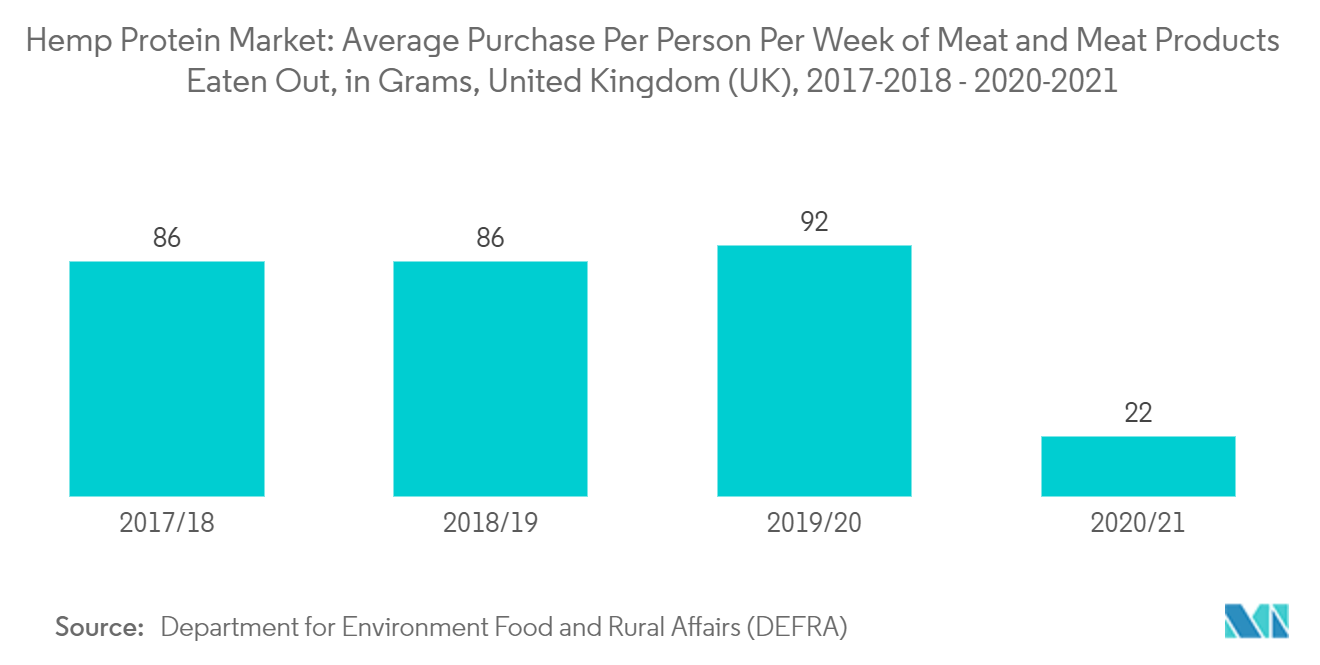
North America is a Major Market for Hemp Protein
- The hemp protein market has been growing across North America, owing to various factors such as an inclination toward plant protein, increasing fitness trends, growing health and nutrition awareness, food allergies and intolerances, and other such reasons. Additionally, the growing awareness among consumers regarding the health benefits of hemp protein has been driving the demand for hemp protein products.
- Hence, many manufacturers have come forward with hemp protein product innovations, in turn driving the demand for hemp protein ingredients across the region. With its nutty flavor, this nutrient-dense ingredient is being adapted into a wide range of food and beverage innovations in the region, catering to the evolving preferences of consumers.
- Hemp flour can replace the regular, unhealthy maida; nutty in flavor, hemp hearts can be used in making milk, gravies, sweets, and patties; and hemp seed oil can be used in dressings and sauces.
- With this wide range of application capabilities and various restaurants and businesses adopting hemp as their major ingredient, players operating in the regional market are focused on offering new hemp protein ingredients with multiple application capabilities to cater to a wide range of businesses.
- For instance, in June 2022, Applied Food Sciences (AFS), a Texas-based company, introduced PurHP-75TM, a hemp seed protein component. The ingredient's organic component was asserted to be derived from hemp hearts, which have 75% protein and provide all nine essential amino acids. Such factors, supported by the growing health consciousness and inclination toward plant-based food among consumers in the region, are expected to boost the market's growth in the region.
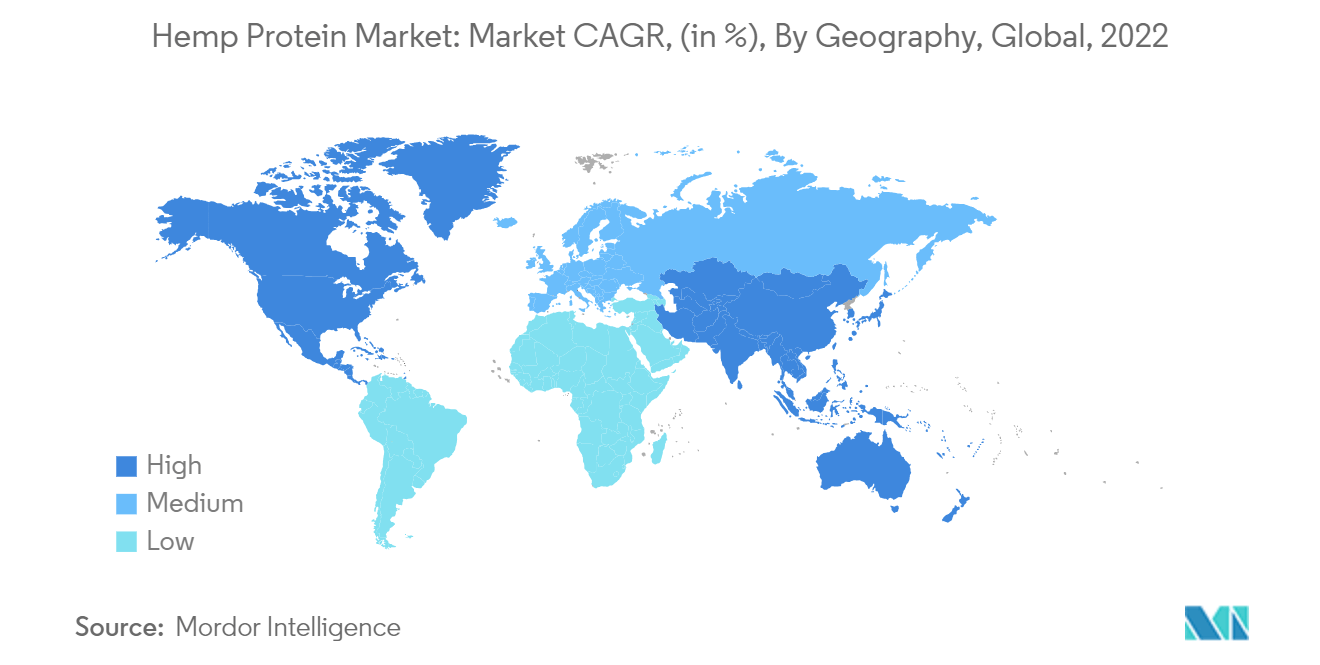
Hemp Protein Industry Overview
The global hemp protein market is fragmented in nature, with top players owing significant market shares across the globe. The major strategies adopted by the players include expansions and acquisitions to establish their position in the market studied. Furthermore, different companies operating in the market have been partnering with various regional distributors to supply their products across their markets. Some prominent players in the market include A. Costantino & C. Spa, Axiom Foods, Inc., MB-Holding GmbH & Co. KG, Tilray Brands, Inc., and ETChem. Furthermore, companies like Bioway (Xi'an) Organic Ingredients Co. Ltd. have been offering organic hemp protein ingredients to suit the growing demand for organic ingredients. Such offerings also aid in the growth of the market studied.
Hemp Protein Market Leaders
-
A. Costantino & C. spa
-
Axiom Foods, Inc.
-
Tilray Brands, Inc.
-
ETChem
-
MB-Holding GmbH & Co. KG
*Disclaimer: Major Players sorted in no particular order
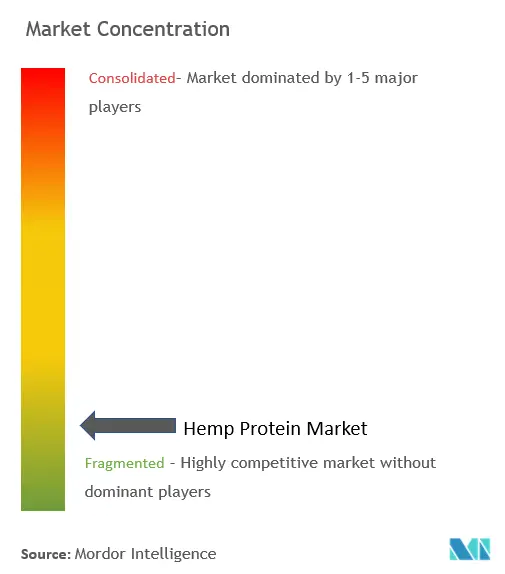
Hemp Protein Market News
- July 2023: Burcon NutraScience Corporation, a global pioneer in plant-based protein development for the food and beverage industry, unveiled an exciting partnership with HPS Food and Ingredients Inc., a worldwide leader in hempseed-based food ingredients. This collaboration aims to explore the commercial potential of Burcon's groundbreaking high-purity, soluble hempseed protein isolate.
- July 2021: Manitoba Harvest, a division of Tilray Brands Inc., announced a significant research collaboration with Protein Industries Canada to drive innovation in hemp and pea protein. This strategic alliance aims to develop new hemp and pea varieties with increased protein content, variable starch levels, and improved texture.
- February 2021: The British Hemp Company (BHC) initiated three major projects as part of its strategy to align people, profits, and the planet. The company proudly inaugurated a state-of-the-art hemp processing mill in Warminster, boasting accreditation from the Soil Association and ISO9001.
Hemp Protein Market Report - Table of Contents
1. INTRODUCTION
- 1.1 Study Assumptions and Market Definition
- 1.2 Scope of the Study
2. RESEARCH METHODOLOGY
3. EXECUTIVE SUMMARY
4. MARKET DYNAMICS
-
4.1 Market Drivers
- 4.1.1 Rising Preference for Plant-Based Protein
- 4.1.2 Prevalence of Consumers Intolerant to Soy, Peanut and Other Legumes is Increasing
-
4.2 Market Restraints
- 4.2.1 Strict Regulation and Policies Pertaining to Hemp Protein
-
4.3 Porter's Five Forces Analysis
- 4.3.1 Threat of New Entrants
- 4.3.2 Bargaining Power of Buyers/Consumers
- 4.3.3 Bargaining Power of Suppliers
- 4.3.4 Threat of Substitute Products
- 4.3.5 Intensity of Competitive Rivalry
5. MARKET SEGMENTATION
-
5.1 Source
- 5.1.1 Organic
- 5.1.2 Conventional
-
5.2 Application
- 5.2.1 Functional Food
- 5.2.2 Functional Beverage
- 5.2.3 Dietary Supplements
- 5.2.4 Pharmaceuticals
- 5.2.5 Personal Care
- 5.2.6 Other Industrial Uses
-
5.3 Geography
- 5.3.1 North America
- 5.3.1.1 United States
- 5.3.1.2 Canada
- 5.3.1.3 Mexico
- 5.3.1.4 Rest of North America
- 5.3.2 Europe
- 5.3.2.1 Germany
- 5.3.2.2 United Kingdom
- 5.3.2.3 Italy
- 5.3.2.4 France
- 5.3.2.5 Russia
- 5.3.2.6 Spain
- 5.3.2.7 Rest of Europe
- 5.3.3 Asia Pacific
- 5.3.3.1 India
- 5.3.3.2 China
- 5.3.3.3 Japan
- 5.3.3.4 Australia
- 5.3.3.5 Rest of Asia Pacific
- 5.3.4 South America
- 5.3.4.1 Brazil
- 5.3.4.2 Argentina
- 5.3.4.3 Rest of South America
- 5.3.5 Middle East & Africa
- 5.3.5.1 Saudi Arabia
- 5.3.5.2 South Africa
- 5.3.5.3 Rest of Middle East & Africa
6. Competitive Landscape
- 6.1 Strategies Adopted by Leading Players
- 6.2 Market Share Analysis
-
6.3 Company Profiles
- 6.3.1 A. Costantino & C. SpA
- 6.3.2 Axiom Foods, Inc.
- 6.3.3 Bioway (Xi'An) Organic Ingredients Co.,Ltd
- 6.3.4 Cooke Inc
- 6.3.5 ETChem
- 6.3.6 Green Source Organics
- 6.3.7 MB-Holding GmbH & Co. KG
- 6.3.8 Tilray Brands, Inc.
- 6.3.9 Foodcom SA
- 6.3.10 GFR Ingredients Ltd.
- *List Not Exhaustive
7. MARKET OPPORTUNITIES AND FUTURE TRENDS
** Subject To AvailablityHemp Protein Industry Segmentation
The cannabis plant produces hemp protein, which is extracted from hemp seeds. The two highly digestible globular kinds of proteins, 2S albumin, and edestin, make up the protein in hemp seeds; edestin is particularly enriched in important amino acids.
The hemp protein market is segmented by source, application, and geography. By source, the market is segmented into organic and conventional. By application, the market is segmented into functional food, functional beverages, dietary supplements, pharmaceuticals, personal care, and other industrial uses. By geography, the market is segmented into North America, Europe, Asia-Pacific, South America, and the Middle East and Africa.
The market sizing has been done in value terms in USD and for volume terms in volume in tons for all the abovementioned segments.
| Source | Organic | |
| Conventional | ||
| Application | Functional Food | |
| Functional Beverage | ||
| Dietary Supplements | ||
| Pharmaceuticals | ||
| Personal Care | ||
| Other Industrial Uses | ||
| Geography | North America | United States |
| Canada | ||
| Mexico | ||
| Rest of North America | ||
| Geography | Europe | Germany |
| United Kingdom | ||
| Italy | ||
| France | ||
| Russia | ||
| Spain | ||
| Rest of Europe | ||
| Geography | Asia Pacific | India |
| China | ||
| Japan | ||
| Australia | ||
| Rest of Asia Pacific | ||
| Geography | South America | Brazil |
| Argentina | ||
| Rest of South America | ||
| Geography | Middle East & Africa | Saudi Arabia |
| South Africa | ||
| Rest of Middle East & Africa |
Hemp Protein Market Research FAQs
What is the current Hemp Protein Market size?
The Hemp Protein Market is projected to register a CAGR of 4.82% during the forecast period (2024-2029)
Who are the key players in Hemp Protein Market?
A. Costantino & C. spa, Axiom Foods, Inc., Tilray Brands, Inc., ETChem and MB-Holding GmbH & Co. KG are the major companies operating in the Hemp Protein Market.
Which is the fastest growing region in Hemp Protein Market?
Europe is estimated to grow at the highest CAGR over the forecast period (2024-2029).
Which region has the biggest share in Hemp Protein Market?
In 2024, the North America accounts for the largest market share in Hemp Protein Market.
What years does this Hemp Protein Market cover?
The report covers the Hemp Protein Market historical market size for years: 2019, 2020, 2021, 2022 and 2023. The report also forecasts the Hemp Protein Market size for years: 2024, 2025, 2026, 2027, 2028 and 2029.
Hemp Protein Industry Report
Statistics for the 2024 Hemp Protein market share, size and revenue growth rate, created by Mordor Intelligence™ Industry Reports. Hemp Protein analysis includes a market forecast outlook 2029 and historical overview. Get a sample of this industry analysis as a free report PDF download.



